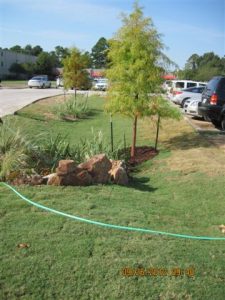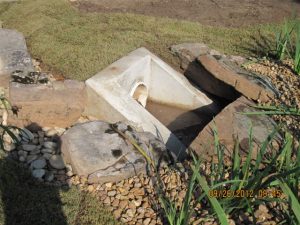Low Impact Development and Site Design
I advocate that all development include low impact site design as an integrated part of design and construction. The marginal increase in cost is more than offset by the benefits to the site, the local ecology and the Owner’s use and maintenance to property especially where storm water detention is required.
Home Bank’s Low Impact Development
Home Bank on Kaliste Saloom Road completed a project that incorporated low-impact development in the required storm water detention areas. In lieu of the ugly brown bottom ponds, they have grassed lawn areas that are easily mowed almost immediately after the water has run off. Use of native planting that doesn’t need irrigation with low maintenance assured.




Key Component of this System:

Section thru bottom of detention area allows water to seep into material that filters contaminants before discharging into the drain below. The filter material also dries out very quickly to eliminate the typical muddy bottom of detention areas.
From Press Release by Lafayette Consolidated Government
Public Works Department highlights partnership for Low Impact Development efforts
Lafayette, LA – Lafayette Consolidated Government is promoting a successful partnership to incorporate Low Impact Development (LID) practices into a recent Lafayette construction project to encourage other construction projects to do the same.
Architects Southwest, Home Bank, Grass Roots, Inc., and Lafayette Consolidated Government worked together to incorporate LID designs in the expansion of the parking at the Home Bank Location at 503 Kaliste Saloom Road.
Like other municipalities and parishes throughout Louisiana, Lafayette Consolidated Government has a Municipal Separate Storm Sewer System (MS4) permit with the Louisiana State Department of Environmental Quality. The origins of this permit come from the Federal Clean Water Act of 1972. The purpose of the MS4 permit is to prevent harmful pollutants from being washed or dumped into surface waters. The MS4 collects and conveys stormwater to drainage ways. The MS4 is the storm sewer system, and it is separate from the sanitary sewer system.
The storm sewer system comprises the Bayou Vermilion Watershed. A watershed is an area of land that drains to a common waterway. A watershed is comprised of storm drains, ditches, coulees, and smaller bayous that can lead to the Bayou Vermilion. This surface water is not treated or cleaned before it reaches the Vermilion. Anything other than stormwater that is spilled, dumped, or leaked onto the ground can be considered a pollutant. Examples of pollutants are motor oil, leaves and grass, paint, dirt, and excessive use of fertilizer and pesticides.
The Public Works Department encourages LID practices because those practices help Lafayette Consolidated Government meet the requirements of its MS4 permit. In the case of the Home Bank parking expansion, architects and landscapers used a site design technique that addresses stormwater runoff. This LID practice is called a Bioretention Swale where curb cuts, rock filters, and native plants help to filter surface water pollutants before entering the watershed. LID practices utilize stormwater as a resource where it can be properly managed to reduce pollution and erosion of the Bayou Vermilion Watershed.
“The Vermilion River is part of a larger watershed that includes all of the above-ground and under-ground drainage. LCG has been positioning signs throughout the Parish to raise awareness and encourage pride in our waterways. Utilizing the Low Impact Development designs, like the ones at the Home Bank parking lot, can do a great deal to protect the watershed and improve water quality,” said Bess Foret, Regulatory Compliance Supervisor with Lafayette Consolidated Government.
“Parking lots can become characterless slabs of concrete. When expanding our existing lot at our Kaliste Saloom main office, Home Bank and Architects Southwest chose to maintain the aesthetic appeal of the landscaping around our facility. Through the use of natural plants, trees and boulders, we achieved the look we desired and minimized the environmental impact of the new construction. Keeping local waterways in mind, our drainage areas were designed to prevent an excessive amount of storm water to infiltrate the sewer system at one time. Storm water is also filtered as it drains into the sewer system, a benefit to Home Bank and the city of Lafayette,” said Scott Sutton, Home Bank’s Chief Operating Officer in discussing Home Bank’s decision to incorporate LID practices.
“We view the incorporation of LID practices as having a very practical benefit that incorporates common materials typically used for drainage and landscaping but in different ways to integrate required storm water detention with low maintenance, native plants characteristic of the gulf coast. This installation utilizes landscaping with both native plants and lawn grasses that are exceptionally pleasing to the users, hardy and allow elimination of irrigation systems typically found in landscape beds. A major maintenance benefit is provided by the drainage material below the surface which allows for almost immediate access to the detention areas for grass mowing after wet periods which otherwise are typically saturated and must need several days to dry out if at all. We believe this type of installation is a very cost effective way of limiting the impact on the overall environment while providing as solution to the owner’s needs,” said David Robichaux, Architects Southwest.
“Lafayette Consolidated Government is part of a nationwide effort to protect our resources by better controlling the storm water that is draining into the local waterways. We are promoting some innovative options for managing storm water including attractive and water- friendly alternatives to conventional drainage design practices,” said City-Parish President Joey Durel.
Businesses or residents who have questions about LID practices can call LCG’s Environmental Quality division at 291-5676.
0 Comments Leave a comment